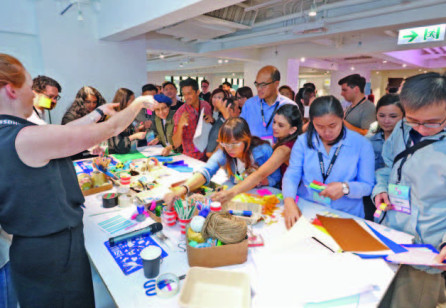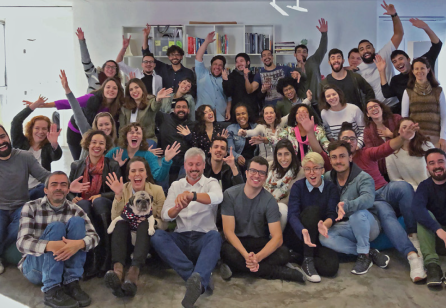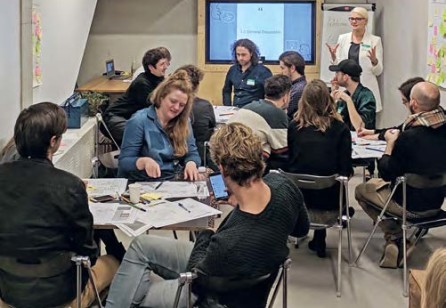Jesse Grimes: Nice to catch up again and see that you’ve been pushing service design and design thinking ever more forward in your part of the world. Can you let me know a bit what keeps you busy?
Eleonora Carnasa: In my work I’m wearing different hats: On the one hand I am a service design practitioner and as such I am involved in innovation projects and in workshop facilitation. On the other hand I have to find a way to make my business sustainable in a very young market. Indeed, doing service design is the hard part, but selling it is even harder. And last but not least, I love developing training programmes that contribute to the development of the horizontal bar of the service designer’s ‘T-shapedness’, such as creative leadership, storytelling, systems thinking and platform design.
How did you come to start practicing and teaching service design?
I wasn’t born a service designer, and I don’t have a formal degree in service design. During my education 20 years ago, there was no such thing as Design Thinking or service design. I am an economist and I have an MBA. Later on, I specialised in service design at Central Saint Martins in London, and I took many classes, read books, became part of the SDN and applied my knowledge in practice. I am still learning.
I remember clearly how it all started for me with service design thinking. I used to work for the Bulgarian Chamber of Commerce and Industry as an innovation management consultant, and at some point made a specialisation at the European Innovation Management Academy. It involved a questionnaire you use to assess companies’ innovation management capabilities, and there were a few questions about the application of the design approach to innovation. They triggered me to dig deeper and deeper into the topic and educate myself. It was only a matter of time before I had set up my agency as a side project initially, which then became my main focus.
As someone wise once said, the best way to learn is to teach, and I enjoy sharing my knowledge with other people. Recently I received an offer from a private Bulgarian university to lead a three-month extracurricular course in Sofia, and I am still considering if it could fit into my agenda, but it is a positive sign of the growing interest in the discipline.
You have worked with different types of clients, both international corporates, as well as local firms in Bulgaria. What type of work do you find the most rewarding, and what differences do you see in the level of service design demand and maturity between your local and European clients?
The difference in demand and understanding of service design in the different corners of the continent is significant in my experience. When relocating for a project or workshops, it feels like travel in time. Right now, I am in Helsinki delivering a series of workshops on service design and creative leadership at Laurea University. So far, I had over 100 participants, and each one knows what service design is, with many wanting to pursue a career in the field. I even had participants from the public sector whose bosses have encouraged them to learn service design and apply it in their work.
Elsewhere in Western Europe I’ve been involved in large-scale service design operations with big budgets and huge support infrastructures. In those cases, service design (sometimes called Design Thinking within the organisations), was regarded as a means to achieve customer-centric business transformation with the potential to introduce changes to the organisational system. What I find exciting in those cases is leading and observing the required mindset changes associated with the design of services that are beyond the typical industry offering. The downside is that big companies are very political, there is no complete buy-in and support from the leadership, and in general they are slow to change.
Back home when working with start-ups, the challenge is quite different. They are quick to act, but lack the skills and understanding of design research and customer discovery. Venture capital money is spoiling them, and they don’t feel the necessity of putting in extra effort. I can share many examples of start-ups that don’t sell anything but themselves, moving from one accelerator to the next.
In Bulgaria, service design is terra incognita for the public and healthcare sectors, which leaves us the private and non-governmental sectors as the only clients. Much to my regret, businesses still contact us predominantly for workshops and even teambuilding events. This despite the fact that I believe that service design is much-needed when businesses are operating in a functioning market economy in which service providers are competing between themselves to create better customer experiences. We have a different picture at home, because we see many businesses don’t really care to improve because their sales are guaranteed due to a distorted market.
I think that readers are often interested in the different ways that service designers have addressed the challenges of introducing, selling and practicing service design in new frontiers. You’ve made clear that Bulgaria is one of these markets which has yet to catch up to Western Europe in terms of the awareness of what service designers do, and what the practice can achieve. What have been your strategies to make service design successful there, and how have you overcome any difficulties?
Indeed, the market is in its infancy and there are not so many messengers to deliver the message. There are a few small agencies like mine, but other than that no-one is investing in awarenessraising. If you do a LinkedIn search for service designers in Bulgaria, you will be surprised to find out that there are no people with the job title except for a very few freelancers. Simply nobody is hiring service designers yet.
My strategy is to create a lot of content and to attract followers by representing the SDN in Bulgaria. Luckily, I got some EU funding and I have an on-going project to create service design training materials and to organise free workshops. In addition, I just organised the first Design Thinking Camp in Sofia on August 29-30, with 25 international speakers and 16 workshops. The focus in Bulgaria is still on Design Thinking, and for the moment I am content on focussing on that term, as long as it delivers value to my clients and their customers.
So, still a long way to go to establish service design as a discipline in Bulgaria, but exciting times ahead!









Share your thoughts
0 RepliesPlease login to comment